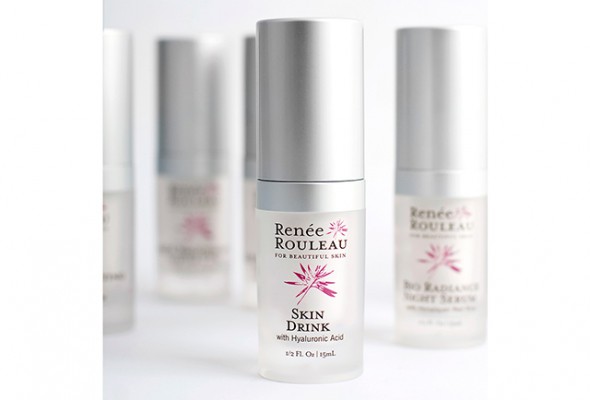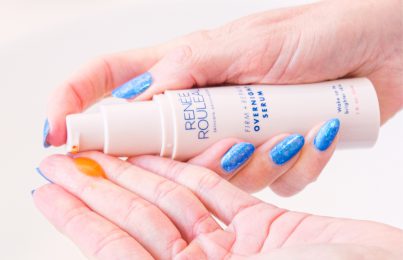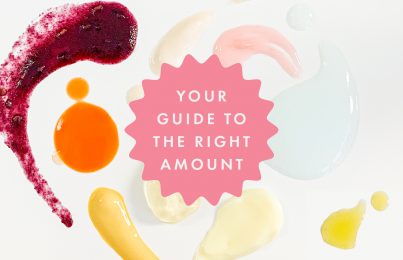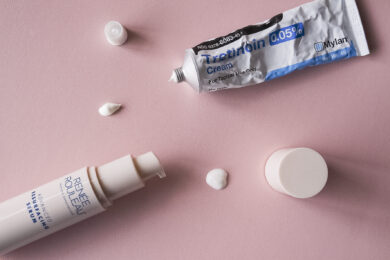A skin serum is a skin care product that contains a higher concentration of active ingredients and usually comes in a gel or creamy gel form. It is meant to be used under a moisturizer or mask to give a boost of results to the skin.
If you have two serums and they each offer different benefits that your skin needs, can mixing them together and applying to the skin give you enhanced results?
The answer is yes! I recommend layering them on one at a time versus actually mixing them together in the palm of your hand.
Here are two examples as to how using two serums can offer you extra skin benefit:
-Let’s say you’re breaking out, but your skin is feeling dehydrated too. After cleansing, layer on a coat of an oil-free serum that contains hyaluronic acid like Skin Drink. (Read about the benefits of hyaluronic acid.) Then layer on a thin coat of Anti Cyst Treatment to the areas that are breaking out. Let dry and the follow with an oil-free moisturizer like Sheer Moisture. (Note: While Anti Cyst Treatment is formulated for spot treating painful cystic blemishes, it’s also really beneficial for preventing ALL TYPES of blemishes when used in areas prone to acne.)..
– If I have a new client and she mentions that she has an expensive vitamin C serum from another skin care line that she can’t use very often because it stings and irritates her skin (which is common with vitamin C serums), I will suggest this instead. Despite having our Cosmetic Donation Program, where we encourage our clients to donate their gently-used products if they are not getting use from them, understandably some clients don’t want to give away really expensive products. So in this case I’ll suggest they purchase our no-sting Vitamin C&E Treatment since it’s excellent for sensitive skin and layer it on first, then layer on a few drops of the other vitamin C serum over it. By putting a first layer of the gentler formula, the second product will be less likely to cause irritation since it’s not directly touching the skin. Plus, when it comes to using a face serum, there are many great forms of vitamin C available that offer excellent antioxidant benefits, and since many lines may use different types than what our Vitamin C&E Treatment uses, she actually is giving her skin a more powerful dose of antioxidant protection. So this works out very well to layer, yet reduce the skin sensitivity.
New Beauty Magazine recently had an article about the common types of vitamin C and here is what they reported.
L-Ascorbic Acid – is not very stable and can lose its effectiveness quickly.
Magnesium Ascorbyl Phosphate – a water-soluble gentle form of vitamin C ester and is ideal for those with sensitive skin.
Ascorbyl Palmitate – the fat-soluble form of vitamin C which allows it to penetrate quicker and deeper.
Read: Five Skin Care Ingredient Myths You Need to Know
What ingredients should not be used together?
Some ingredients should not be used together as they can irritate the skin, cause negative reactions, or cancel out the effects of both. They can be used at different times of the day, just not at the same time.
-Avoid mixing retinol product with Benzoyl Peroxide.
-Avoid mixing retinoids or hydroquinone with glycolic acid.
-Avoid mixing vitamin C with copper peptides.
One other tip worth noting: It’s best never to mix your sunscreen and your moisturizer together because then you are not getting the full SPF number listed on the bottle. If your skin is in need of extra hydration, using an extra moisturizing serum layered under your moisturizer along with your daily vitamin C serum will do the trick. Getting the full benefit from your sunscreen is important considering UV exposure is the #1 cause of premature skin aging.
Read: My Five Favorite Tips for Protecting Your Skin from the Sun
Which products are right for your skin? See our nine skin types and get products recommended.
Need expert advice from a licensed esthetician? Schedule My Skin Prescription to get personalized advice in person, over the phone or via Skype or Facetime.
For more expert skin advice, check out Skin Source–the A-Z guide on all things skin. Also sign up for our skin tip e-newsletter, follow Renée Rouleau on Twitter and join the discussion on our Facebook page. You’ll be your own skin care expert in no time!
Celebrity Esthetician & Skincare Expert
As an esthetician trained in cosmetic chemistry, Renée Rouleau has spent 30 years researching skin, educating her audience, and building an award-winning line of products. Her hands-on experience as an esthetician and trusted skin care expert has created a real-world solution — products that are formulated for nine different types of skin so your face will get exactly what it needs to look and feel its best. Trusted by celebrities, editors, bloggers, and skincare obsessives around the globe, her vast real-world knowledge and constant research are why Marie Claire calls her “the most passionate skin practitioner we know.”




Comments:
can a few drops of hyaluronic acid be mixed in with my moisturising cream.
Posted By: Eileen Roche |
Sure, that will work.
Posted By: Renée Rouleau |
hello, I have dry, itchy and mild acne prone skin. my skin doc prescribed me Epiduo which contains 2.5% Benzoyl peroxide and .1% Adapalene. Since i already have dry skin I am a little hesitant towards starting this treatment. My question is, can I use hyaluronic acid serum along with benzoyl peroxide. Will it be of any help or would it just have negative effects? Thank you.
Posted By: sahii |
Since you have some prescription products that you are using, it’s best to check with your doctor however, in my opinion, using HA along with BP should be fine.
Posted By: Renée Rouleau |
Hi!! I would like to use hidroquinone for some dark spot, I use vit c serum, alternate retinol and aha. How should I layer hydroquinone? Thanks!
Posted By: cangrejamora |
If you gave gotten a prescription for hydroquinone, that I would ask your doctor how they suggest you use it. If it’s a lesser-strength, over the counter type, I would suggest using it like this and see how your skin responds. Vitamin C under sunscreen during the day. At night, I would suggest you use retinol on night one, hydroquinone on night two and an AHA on night three and keep repeating this. The reason why I suggest you use each on its own is because you’ll be getting the full benefit of the product whereas if you layer them, then you might be wasting some of the product that goes on top if it can’t fully absorb into the skin.
Posted By: Renée Rouleau |
Thank you!!!
Posted By: cangrejamora |
hi, can i use the morning, vit c , ha, together . is itok forme, and also please advice for moisturizer on the vit c ,ha , for morning , thank you
Posted By: ella |
I’m not really understanding your question but to get information on a skin care routine for your skin type, take my Skin Type Quiz.
Posted By: Renée Rouleau |
I have used tretinoin 0.1% for 2 years now. I wanted to add glycoloic acid and hyaluronic acid serum to my daily regimen. How would I go about this? Can they be used on top of each other. And should I use at night with tretinoin or morning? Thank you!
Posted By: Brenda |
Great question, Brenda! I have written a blog post that will tell you exactly how to use retin-a (tretinoin) and how to use the other products you speak of. Read this https://blog.reneerouleau.com/are-you-using-retinol-based-products/
Posted By: Renée Rouleau |
Is it ok to layer any serums with prescription retinoids, such as vitamin c or a hyaluronic acids serum? Which should be applied first?
Posted By: Stacey |
I wouldn’t use vitamin C simultaneously with a prescription retinoid but using a hyaluronic acid serum over it won’t hurt anything.
Posted By: Renée Rouleau |
So if I put a serum on, then an eye cream….I can use 10% glycolic acid after that? (My serum has no retinoids or hydroquinone.) Will the glycolic acid still work on top? I wonder if it will actually penetrate? Then for daytime…..on top of all that could I use moisturizer with a spf? I don’t really have time to wash my face a third time to apply glycolic acid by itself.
Posted By: Jennifer |
Hi Jennifer, If you put a serum on, then an eye cream and then an acid, no, the glycolic will definitely not be effective. Your skin can only absorb so much. Glycolic should be used a few nights a week (use other serums on other nights) after toning and before moisturizer application. If you take our SKIN TYPE QUIZ, it will not only recommend products but tell you exactly the order of how to use products.
Posted By: Renée Rouleau |
I read on one blog that vitamin C should not be mixed with hyaluronic acid, but others say it is fine to mix them. Your thoughts? Thank you!
Posted By: Joy |
I have not seen any research on why HA should not be used with vitamin C. Did they give a reason for it? It’s all good to use according to me!
Posted By: Renée Rouleau |
I see in the article that the author recommends not mixing your sunscreen with your moisturizer. I use a moisturizer that has an spf 15 rating, the Say Yes to Carrots one, is that not good enough? Should they be separate?
Posted By: Meredith |
It’s perfectly find is the formula has moisturizer built in, it’s simply that I don’t recommend you take two different products (moisturizer and a sunscreen) and manually mix them together yourself. Also, I do suggest a minimum of SPF 30 like this one. https://www.reneerouleau.com/products/daily-protection-spf-30
Posted By: Renée Rouleau |
If I were to use a peel off mask what can I put on the skin first after I have done exfoliating , I would be using a cold mask.
Posted By: Jeannie |
I always suggest using a serum under a mask but I’m not sure how that will effect how the mask might pull off. There are many different types of peel off masks so I’m not sure of yours. But generally our serums are great to use. Be sure to look at our nine skin types to get products suggested. https://www.reneerouleau.com/skin-types
Posted By: Renée Rouleau |